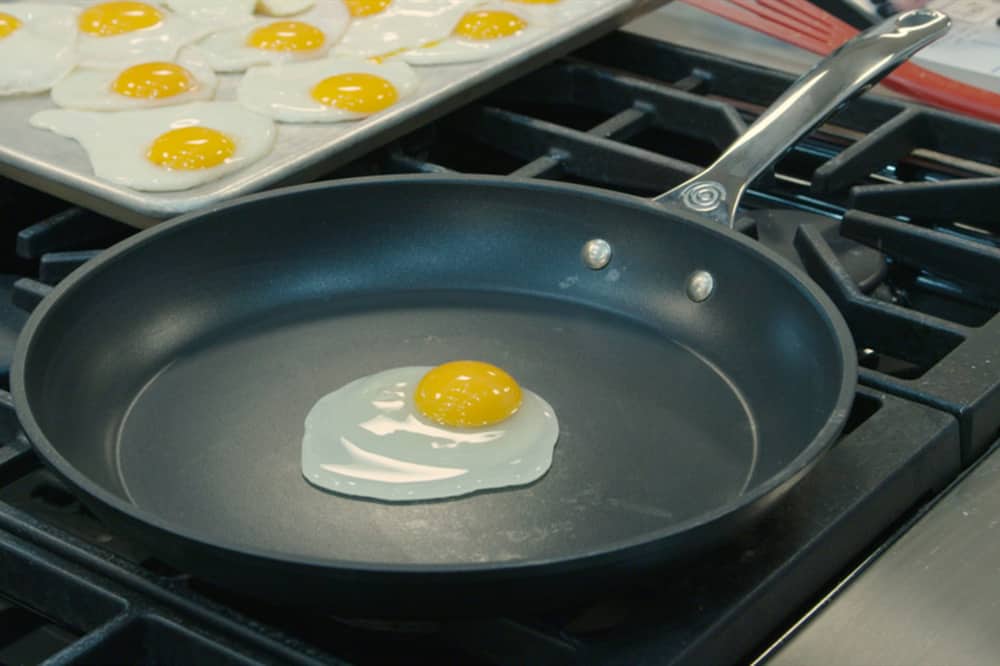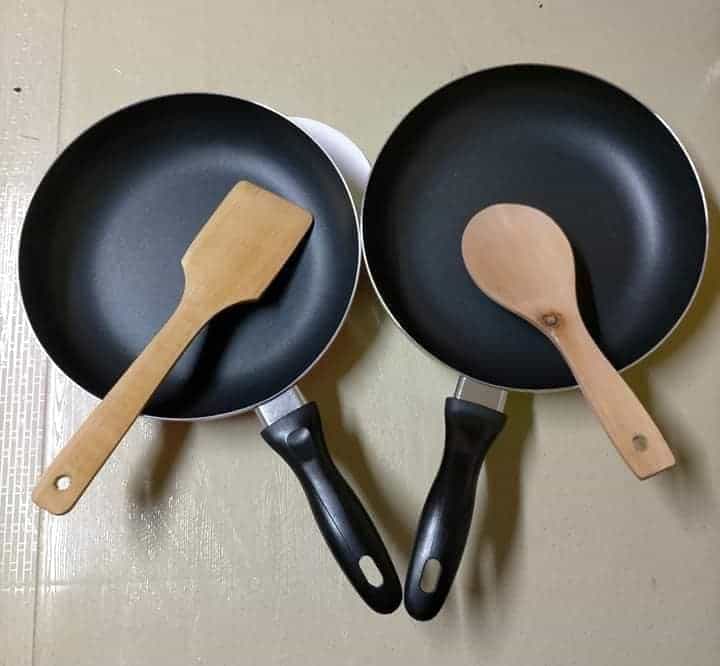For a beginner cook, it can be tricky to choose among the growing variety of cookware out there. Among the most common questions asked when selecting cookware, especially for pans, are: What are the types of pans? What is a dark coated pan? When is the best time to use one over a light pan? Read on to find out!
What is a Dark Coated Pan?
A dark-coated pan is made of metal. Usually, aluminum, tin, or stainless coated with a substance that typically gives it a nonstick characteristic.
In the same way that you wear light-colored clothes under the hot summer sun and avoid dark clothes outside, you use a light-colored pan if you want gentler heat onto your food.
Just as wearing light-colored clothes under the hot summer sun keeps you cooler than dark clothes, using a light-colored pan can result in more gentle heating of your food.
Dark Coated Pan vs. Light Coated Pan:
| Features | Dark Coated Pan | Light Coated Pan |
|---|---|---|
| Heat Conduction | Heats up faster. | Heats up slower. |
| Cooking Results | Good for quick, high-temperature cooking. | Good for slow, low-temperature cooking. |
| Cleaning | Shows less stains/scratches. | Shows more stains/scratches. |
| Visual Effect | Looks durable, professional. | Looks modern, minimalist. |
| Usages | Suitable for grilling or searing. | Suitable for baking or simmering. |
3 Types of Dark Coated Pans
Nonstick Pans

A nonstick pan has become a necessity for cooks everywhere because it is affordable, easy-to-use, and widely available. You don’t have to spend so much time stirring and ensuring your food doesn’t get burned.
A nonstick pan is made from aluminum or stainless steel material and then coated with a nonstick substance called Teflon.
Teflon, also known as Poly-tera-fluoro-ethylene (PTFE), first came about in the 1930s for wire coatings but was eventually used on pans in the 1950s to prevent food from sticking on the interior surface.
Teflon covers the surface and blocks food from seeping through pores of the metal enlarged after being heated to high temperatures.
Since 2013, manufacturers of nonstick pans have stopped using Perfluorooctanoic acid (PFOA), a dangerous chemical linked to health problems, in the production of pans. This means that Teflon-coated pans today are free of such toxic binding material and, therefore, safer to cook in.
Pros of nonstick pan:
- Easy to clean.
- Less oil needed.
- Good for delicate foods.
- Even heating.
Cons of nonstick pan:
- Less durable.
- Not for high heat.
- Old models may contain PFOA.
- Can’t use metal utensils.
- Limited oven use.
Anodized Aluminum Pans

Aluminum cookware that has undergone an oxidation process becomes harder and more durable than standard aluminum cookware, resulting in a hard inner layer with a smooth, nonstick surface This is done by immersing the metal in a chemical bath and applying an electrical current to it.
Among the advantages of this type compared to regular aluminum is that it does not dent easily. It is also more resistant to corrosion due to its thicker layer.
Pros of Anodized Aluminum Pans:
- Even heating.
- Scratch and stick-resistant.
- Durable.
- Non-reactive with acids.
Cons of Anodized Aluminum Pans:
- Not dishwasher safe.
- Not for high-heat cooking.
- Often not induction compatible.
Although they are not as expensive as copper and stainless steel pans, they are more costly than a convenient and beginner cook’s regular nonstick pans. But it is definitely worth the extra bucks!
Ceramic Pans

Ceramic pans are a rising star when it comes to cookware as it comes in aesthetically pleasing looks and colors. They are not entirely made of ceramic but crafted from an aluminum or stainless base material then sprayed or coated with a sand-like mineral component.
This results in a glass-like finish that is nonstick and non-reactive. Aside from having a sleek and modern appearance, it is marketed as a non-toxic and more eco-friendly option than regular nonstick pans.
Pros of ceramic pans:
- Non-Toxic
- Non-Stick
- Good Heat Distribution
- Oven-Safe
- Aesthetically Pleasing
Cons of ceramic pans:
- Less Durable
- Lower Heat Tolerance
- Higher Cost
- Need Careful Maintenance
When to use dark or light pans?
For baking pizza, potato wedges, or pies, consider reaching for the darker metal pan as it will absorb more heat, thus giving them crispier edges and crusts. Make the most out of your dark baking pan with quick-baking items such as muffins and biscuits as well.
When baking cakes and cookies, opt for a lighter metal for an evenly radiated heat. This will also ensure the bottom of your cake does not brown too quickly.
You don’t have to discard the dark metal sheet pans that you have because you can manipulate the baking time and temperature. A general tip is to lower the heat of your oven by 25 degrees to prevent overexposure.
For example, if the recipe instructed you to bake your cake at 350◦F for 45 minutes, set your oven at 325◦F instead. You can also line your pan with a sheet or two of parchment.
4 Tips for Maintaining Your Pans
Long-time cooks will advise the same thing about your cookware: Give it some love, and it will serve you an extended period of time, probably just like any other thing in the world.
Use silicone or wooden spoons

To prolong the quality of your coated pan, you should avoid using metal utensils in contact with the surface to prevent scratching and leaving unwanted marks. This is an excellent thing to keep in mind, especially when cooking your favorite scrambled eggs.
Cool before cleaning
When it is time to clean your pans, you should let them cool down first in temperature for a few minutes before throwing them in the sink and soaking it in warm and soapy water.
A hot pan exposed to cold water is at risk of warping, chipping, or cracking due to thermal shock. The amount of time you can wait before it cools also depends on the type and weight of the pan. Heavier pans retain heat longer thus will take longer to cool.
Avoid using the dishwasher unless it claims to be dishwasher-safe

Part of the consistent maintenance of your pans is knowing if they are dishwasher friendly. The extremely hot water plus the chemicals of the detergent in your dishwasher react to the materials of the pan.
In the long run, it will lose the color, shine, coating, and then rust. This is especially very applicable for your dark coated pans. While it is more convenient and time-saving to put your greasy pans in the dishwasher, the better alternative is to hand wash them.
Use a gentle scrub brush and dishwashing liquid
For nonstick pans, no matter how difficult it is to clean and remove stuck residue, don’t use steel wool and other harsh cleansers to wash your pan.
It will be better to use a soft sponge or cloth for the long run, so you won’t gradually scratch away the pan’s coated surface, thus prolonging its life.
Restoring your Blackened Pans

Don’t worry if you happen to be late to reading these tips and have already subjected your pans to the dishwasher, an abrasive brush, or directly soaking your hot pans in cold water!
To restore them, you can follow these three keywords: soak, scrub, and spray.
Soak:
- Fill your pan with water and add a few tablespoons of lemon juice.
- Boil for 10 minutes.
- Drain the water.
- Sponge off with soap and water to lift off built-up grease and grime.
- Dry it afterward with a clean cloth.
Scrub:
- Prepare a mixture of baking soda and white vinegar.
- Scrub the discolored interior and exterior of the pans with this mixture.
- Let the paste stand for a few minutes.
- Wipe away with a scrub.
- Rinse and dry.
Spray:
- If any more discolored spots remain, prepare a solution of equal parts water and vinegar.
- Spray the solution on the spots.
- Rinse and dry after wiping away with a scrub or steel wool pad.
For severe cases involving years’ worth of neglected burnt grease and rust:
- Spray oven cleaners thoroughly on the pan, including handles, interior, and exterior.
- After spraying, keep the pan in an enclosed bag.
- Remove it after several hours or even overnight.
Rinse and dry the pan before using.
Note: These oven cleaners are very harsh and toxic, so protect yourself with rubber gloves and a face mask while in a well-ventilated area.
Watch this video to see this hack in action:
Summary
Reading up before making that rushed purchase decision will save you not just money but also the quality of the food you prepare. Now that you are informed about the characteristics of a dark-coated pan, you are in a better position to compare and decide whether it’s the right choice for your next recipe.


Michael Johnson is the founder of Pan Mastery, Inspired by his blacksmith grandfather’s legacy has a deep appreciation for hand-crafted pots and pans, he provides invaluable guides, reviews, and recipes to enhance your culinary journey.

